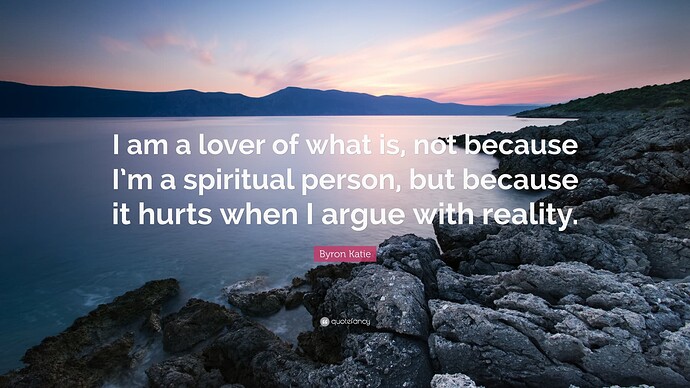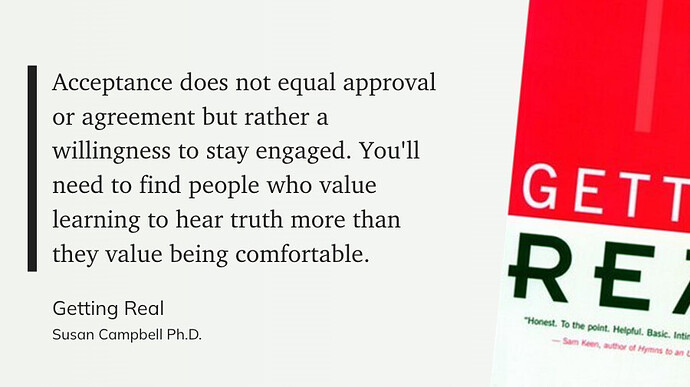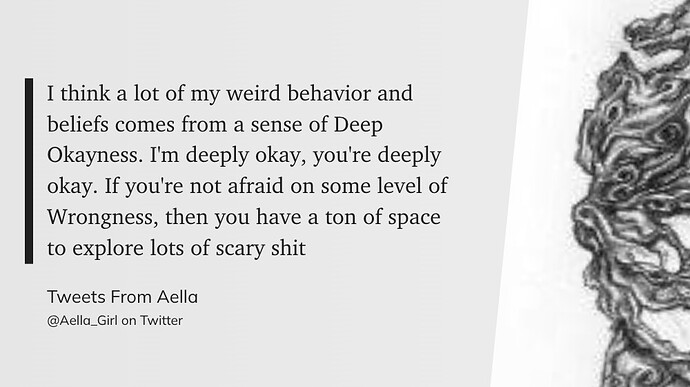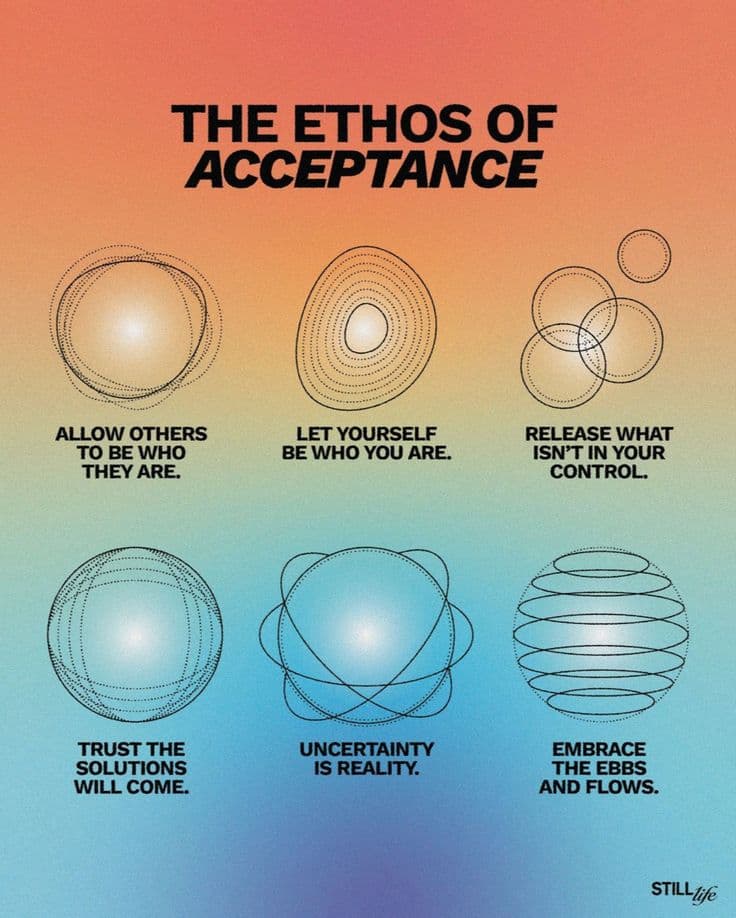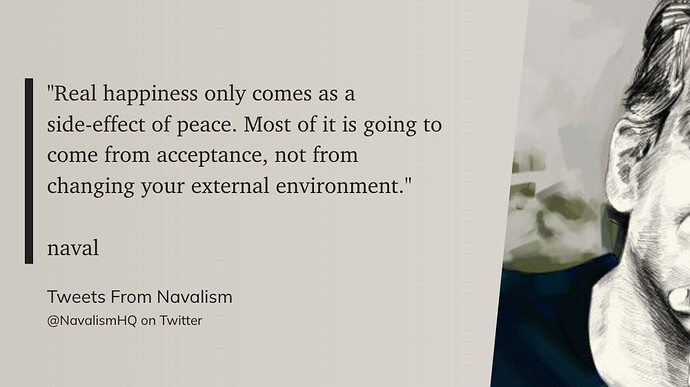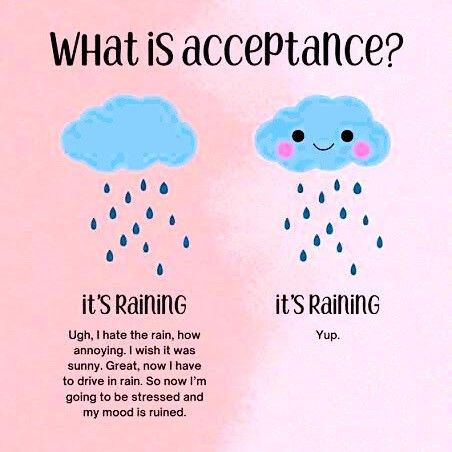It hurts when I argue with Reality.
For so long I thought it was “the reality” that hurt. Sometimes, and I’ve noticed by accepting unwanted reality that the hurt’s complexion changes so much. It’s more sadness than strain, a respect rises that I do want and intend the world to be different – even when it isn’t – that fuels me to keep going, keep adding hearty value, rather than shake fists impotently at the sky in frustration…
A reminder that this book is an excellent resource for Acceptance. When we can be with what’s real, our resilience grows dramatically.
Stop fighting what is.
When we stop fighting what is, we open a pathway towards adapting for OUR thriving.
The more of us who feel emotionally free to adapt for OUR thriving, the more people will thrive! The more options will be emblazoned across the energy field of what is possible.
Wow, nice. Deep Okayness. Acceptance of our weirdness and cultivating an immunity to “wrongness” about who we are and what matters to us and how we express our heartistry.
I think a lot of my weird behavior and beliefs comes from a sense of Deep Okayness. I’m deeply okay, you’re deeply okay. If you’re not afraid on some level of Wrongness, then you have a ton of space to explore lots of scary shit – @Aella_Girl on Twitter
Life is what it is… but only always. – Peter Crone
The Ethos of Acceptance
• Allow others to be who they are.
• Let yourself be who you are.
• Release what isn’t in your control.
• Trust the solutions will come.
• Uncertainty is reality.
• Embrace the ebbs and flows.
Uncertainty acceptance is the super-useful practice for me…
I sure do need these lessons!!! This is so true, thank you for posting ![]()
“Real happiness only comes as a side-effect of peace. Most of it is going to come from acceptance, not from changing your external environment.”
This resonates with me soooo much!
Explorations - Acceptance
If I accept this as it is, won’t I get stuck here or “let them off the hook”? Where’s the line between acceptance and complacency?
There’s a big difference between accepting an unwanted reality as reality… and tossing up our hands, freezing, or fighting what is. When something isn’t how it needs to be for our well-being, resistance naturally rises. And in that resistance there’s energy: this is not okay, this is not what I want, this could be better.
The stuckness happens when that becomes our ongoing focus. Our primitive brain wants to fixate on the not-okay. If you’ve ever spent hours grinding on a problem, only to realize later that nothing moved, you’ve felt this. Acceptance is the proven tool that says: yes, this is an unwanted reality—and it is reality.
EFT Tapping is built for this. Its setup reminds us: I accept myself where I am, right here, right now. I accept that this situation is real, even if unwanted, right here, right now. From there we can ask, where do I want to direct my energy now?
That question is the hinge. Complacency says, there’s nothing I can do—full stop. That’s a lie our nervous system tells to feel safe by avoiding action. It can feel like letting go, but it’s not freedom and it’s not personal agency.
Acceptance frees agency. When we feel free to choose—even tiny choices—we can look for micro-steps, small yeses that make things a bit better.
It’s the lack of acceptance that keeps people stuck. If I sit with someone and we both acknowledge, yep, this is an unwanted reality… then we can ask, what small improvement is possible? The reflexive answer from resistance is: no, it’s wrong, I need to fix it now. But nearly everything real in life changes through small increments.
So we accept the unwanted reality—about health, relationships, work, money—and we open ourselves to options. Explore with people who are good at options. Generate five possibilities, including the primitive brain’s favorite like running away to a cave. It’s okay to name that one. By not forcing anything to be what it isn’t, we create a real menu. From that menu, we can choose one small, meaningful, inspired action.
That’s not complacency. If you’re taking even a small action with the intention of making things a bit better, you’re not complacent at all. Are you letting them off the hook if you move on with your life? No. Are you letting them off the hook if you say, hey, that hurt—don’t do it again? No. Better Boundaries can coexist with acceptance.
Our primitive brain wants to fight, flee, or freeze. Acceptance helps us stay with the truth of the matter as we perceive it now, and move our energy differently.
Practically, this looks like:
- Grounding: hand on heart, name the unwanted reality, and breathe. I accept that this is how it is right now.
- Feeling: allow the not-okay to be felt without making it the only thing. Tap while saying, even though I really don’t like this, I accept myself anyway.
- Choice: ask, what’s one small action that nudges this toward better? A text. A boundary. A rest. A plan. A tiny test.
- Iterate: take the step, notice the effect, and pick the next small yes.
Acceptance is masterful because it redirects energy from arguing against reality into adapting with reality. It doesn’t excuse harm. It doesn’t cancel consequences. It restores clarity, steadiness, and choice—so we can do the next right, doable thing.
How do I accept parts of myself I really don’t like—feelings, habits, reactions—without shaming or giving up on change?
It starts by remembering that acceptance means, hey, this is a reality—an unwanted reality—but it is where I am right now. By doing that, we stop wasting our precious life force and say, “Okay, this is where I am.”
Imagine you head out for a walk to the park and instead end up at the sewage treatment plant. It really stinks. As soon as you realize you’re not at the park and you took a wrong turn, how long do you want to stay there—feeling horrible, shaming yourself, calling yourself stupid, or giving up?
Most of us would say, it stinks here… time to walk back toward the park.
The truth is, most of us are conditioned to react rather than respond. When I use EFT Tapping around a feeling, habit, or reaction I want to shift, I start with: I accept this is where I am right now… and I’ve decided to get better at this. I’m learning more balance. I’m developing the skill of greater resilience.
Notice what happens? If I keep ending up at the emotional sewage plant, I’d say: time to get an emotional compass and learn how to use it. Time to be more present as I walk. I know what the park feels like and the general direction. I might even know the specific steps. Maybe I was distracted? Maybe I focused on something else and wandered where I didn’t want to be? That’s human. There’s so much pulling on our attention that we lose presence.
Accepting parts I don’t like means acknowledging—even honoring—yeah, this reaction happens. If shame starts, tap on the shame. If you’re giving up on change, that’s a clue acceptance hasn’t landed yet.
“Oh, I’ve given up changing my eating behavior.” Okay… accept that right now you’re not acting in ways that are mindful, present, and grounded in what truly matters to you. Because when you’re grounded in what matters, you settle and strengthen into it.
I believe in your power to change this. And I know acceptance isn’t always socially acceptable—people give you more points for being hard on yourself. They want you to look ashamed if you or they don’t like your behavior. It’s just not useful for thriving long-term. Accept and give it honest energy. Accept… and make small incremental changes.
How can I accept someone as they are when their behavior hurts me or crosses my values—and still set real, enforceable boundaries?
I’ve seen a lot of suffering come from arguing that someone shouldn’t be the way they are, shouldn’t behave the way they do, that they could do better.
Maybe that’s true. Most often… it isn’t. We just wish it was!
If we’re going to set healthy boundaries, it starts with: this is a behavior they actually have.
Feel the difference between “they shouldn’t behave that way” and “I acknowledge and accept the unwanted reality that they behave that way—toward me, toward others, toward themselves.”
There’s an empowered feeling when we accept: THIS IS how they behave. We’re not speaking to their existential or spiritual value. We’re naming what comes out of them in relationship to you, to us, to a space we share—a we‑space.
From there, we can ask: if we’re going to have a better boundary that allows right distance and right depth—safety, respect, and freedom—what does that look like?
I’ve worked with many people raised by parents who did not have the Empathy app. If it were as simple as “install it from the Emotional App Store,” sure… then the boundary would be, I’m not engaging until you install and start using empathy.
But sadly… that’s not how it works. I accept that across the diversity spectrum there are exquisitely sensitive empaths… and there are people for whom empathy is utterly foreign. They might read about it, even try to act it, but the energy isn’t empathy.
Some people are oriented predominantly to their own experience. From the outside it can look like they’re the king or queen of their world—controlling, everyone else less than them. That’s a reality—in fairy tales, politics, homes, workplaces.
And there are other people who genuinely love being of service without hierarchy!
It’s deeply hurtful to be treated as less than by someone who believes they are the master of their universe. It’s brutally hard to cultivate a space where safety, respect, and freedom are essential—and have someone trash it. What do we do?!?
Acceptance frees us: OK, this is what’s happening. This is the behavior. Rather than fantasize about all the potentially legit reasons—trauma, upbringing, whatever—we accept that the unwanted behavior is present.
That frees us to speak to the behavior: “I love you, and it’s not OK for you to do this in a space we share, in this relationship.” That’s a better boundary.
It’s complicated, which is why we’re aiming for an attitude: acceptance says I’m not arguing with reality anymore. I’m not wailing at the sky, complaining about the rain. It’s raining. This person is behaving in ways incompatible with my values. Now what?
In that “now what?” …the suffering loosens. There may still be hurt, but no longer the suffering that comes from insisting reality should be different. They’re not different—maybe someday, but right now, if you want to be Thriving Now, it means recalibrating and setting better boundaries: accept the behavior is happening, name the limit, and choose a next small, enforceable action.
Notice how much ENERGY there is in the resistance side? Wow. The “Yup” accepts and leaves all the life force energy for other things that, actually, can be perfect for a rainy day…
There’s an interesting tension between accepting yourself exactly as you are and acknowledging your capacity for growth.
Both can be true simultaneously: you are complete as you are, AND you contain multitudes of unrealized potential.
The magic happens when you stop seeing these as contradictions and start seeing them as different expressions of the same truth.
Think of a river. At any given moment, it is perfectly complete as it is - every ripple, every current, every reflection is exactly what makes it a river.
Yet it is also constantly flowing, changing, carving new paths, and transforming the landscape around it.
The river doesn’t become “more of a river” when it changes course or shapes new banks - that very capacity for flow and change is essential to what makes it a river in the first place.
Its constant movement isn’t separate from its completeness; it’s a fundamental expression of what a river is.
As are you - infinite, yet complete. @su_dreams
